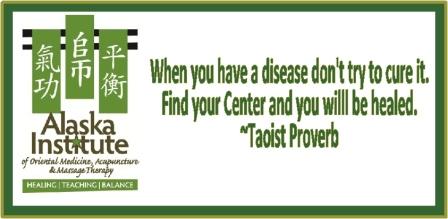By Mary C., Student
When I had my first Oriental medicine healing experience, it was when I was very sick. I had just run the 5k Mud Race that came to Anchorage. My immune system had already been pretty weak prior to running it because of all the stress I had been under. My asthma was acting up and I couldn’t breathe well, and I just felt bad overall. So after I had done the mud race, I thought it was only going to be my body that hurt. Two days after the race was over, I began to feel worse. I couldn’t breathe well at all and I felt weak. I started to get high fevers at night that became low grade during the day. I felt like I was walking in a dream. During the fevers at night, I would sweat so badly that I had to open the windows and have no sheets on me.
When I had my first Oriental medicine healing experience, it was when I was very sick. I had just run the 5k Mud Race that came to Anchorage. My immune system had already been pretty weak prior to running it because of all the stress I had been under. My asthma was acting up and I couldn’t breathe well, and I just felt bad overall. So after I had done the mud race, I thought it was only going to be my body that hurt. Two days after the race was over, I began to feel worse. I couldn’t breathe well at all and I felt weak. I started to get high fevers at night that became low grade during the day. I felt like I was walking in a dream. During the fevers at night, I would sweat so badly that I had to open the windows and have no sheets on me.
My teacher Cynthia was so sweet and asked if I’d like a
treatment. She used some essential oil
blends and rubbed them into my lung meridian when I was supine, as well as
other acupoints that I can’t recall.
During one moment when she hit a point, I felt like someone’s hand was
resting on my lower belly. It was
incredibly weird but calming at the same time.
As if someone was there, helping my healing along. Later I turned over into prone position and
she pressed my Shu Points. I fell asleep
because I was so weak and tired. Later
on I woke up still feeling feverish, but almost like I was getting better
already. Cynthia gave me a special
tincture that I had to take every day in water.
Later on I was given herbal pills from Lamar, our acupuncturist, and I
made and appointment to get acupuncture done too.
For my acupuncture appointment I was given a “clearing” treatment and told to avoid caffeine for a while. This made me sad, but I wanted to get better. I made another acupuncture appointment and began taking the tincture and herbs that were given to me. Within a few days I was already feeling quite amazing. The fevers stopped completely and I felt like my lungs had cleared. I could breathe again! There was also this new energized feeling in my body. It seemed like I had more stamina.
After my second acupuncture treatment I was completely better and felt better than I had before I got sick. It was quite amazing and whatever doubts I had before about Oriental medicine working, were gone. I was a skeptic in some areas, but it seems each time I try these new things it opens my eyes even more. I am so excited I get to practice everything I have learned to help heal others.
Note: The instructors and practitioners at Alaska Institute always encourage patients to see their doctor as needed for health emergencies. There is much we have to offer in the case of non-emergencies, and we take an integrative and respectful approach to working in complement with a person’s conventional medical care.










